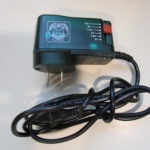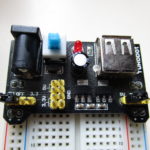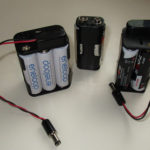powering projects
When you’re first building with Arduino you will naturally power the board off USB and power sensors off the board. That arrangement cannot last forever, though, as you build projects that will be untethered from the computer or need to power things like motors which draw too much current to be powered directly from the Arduino.
Some hobbyists have something called a “variable desktop power supply” to provide the juice to their prototypes, but they are not cheap. Perhaps some day when you have a fully stocked lab you, too, will find a need for one but you can certainly hack away without one of those beasts.
For powering projects off the mains I use an inexpensive power supply that lets me switch between 3V,, 4.5V, 6V, 7.5V and 9V.
To get power onto a breadboard I use the type of breadboard power supply that is ubiquitous on eBay. These supplies provide either 3.3V or 5V, set with jumpers, to the rails on each side of the breadboard so one can be set to a different voltage than the other or shut off entirely.
Everyone is familiar with the snap connectors at the top of 9V batteries. Get a snap connector with a 2.1mm plug on it and you will be able to plug batteries directly into the Arduino or breadboard power supply. You will not be limited to 9V batteries, though, since you can purchase battery holders for AA and AAA batteries with the same snap connectors.


